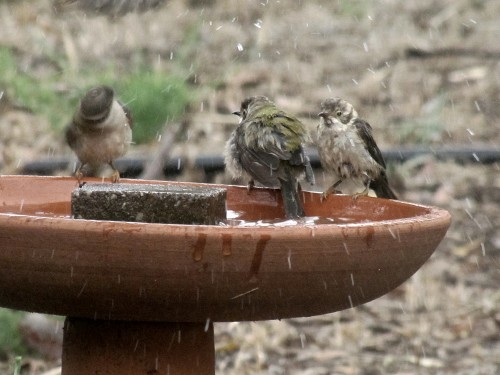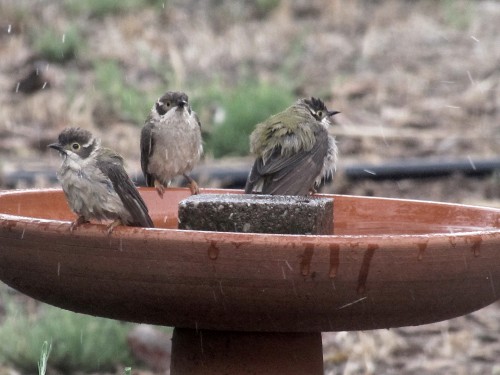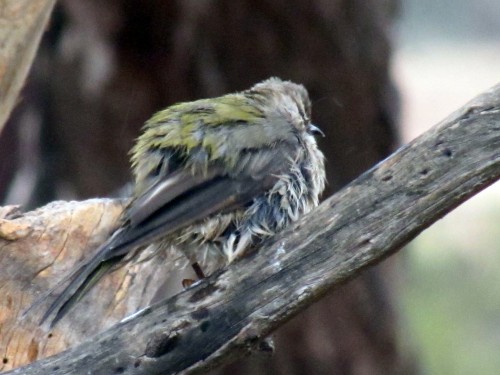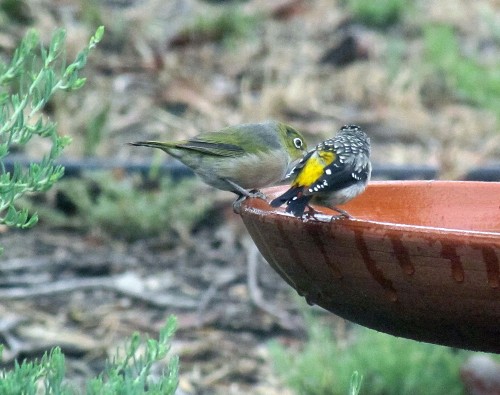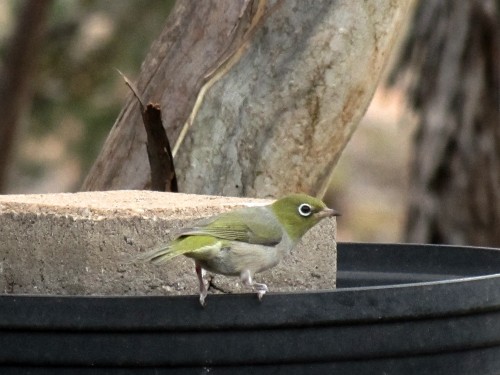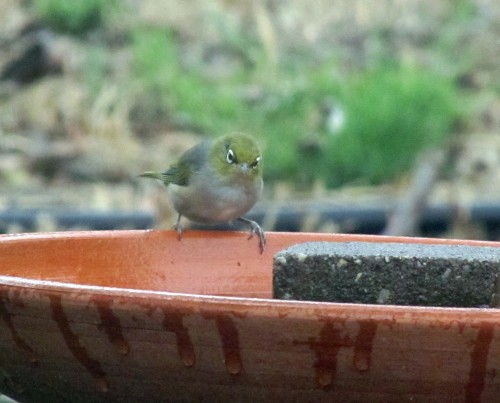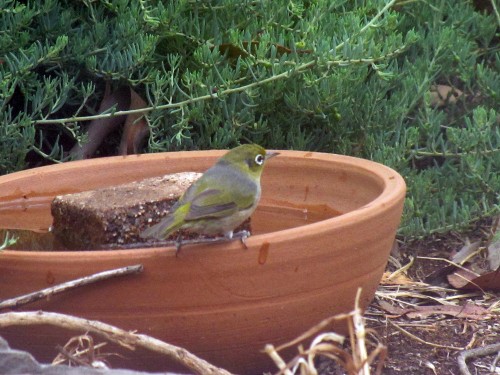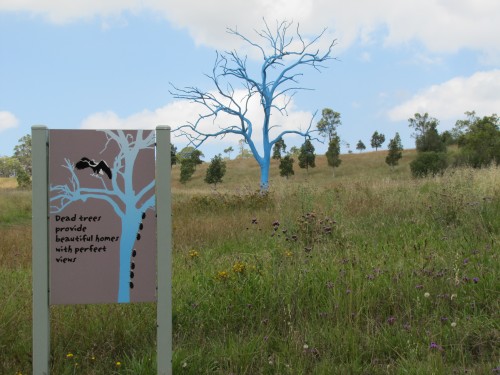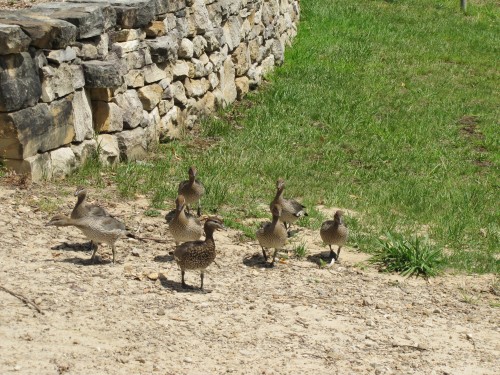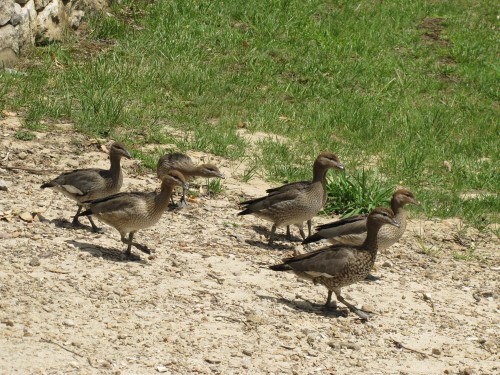Is that a sprinkler?
Our bird baths are very popular with the local resident species, especially on hot days like we have been experiencing here in South Australia this record breaking summer. On the hot days there is a constant stream of birds drinking and bathing.
Some species, like the Brown-headed Honeyeaters shown in today’s series of photos, are no exception. They often come in groups of up to a dozen, sometimes more. When several of them get in and splash around in the cooling water, it looks for all the earth like someone has switched on a sprinkler. Water goes flying in all directions as the birds take on a whirr of activity. Haven’t they heard about conserving water?
And after the drenching bath they retire to a nearby branch to preen and get all those ragged feathers back in line again. No wonder we enjoy watching them so much!
It ain’t half hot
We love our bird baths.
We regard them as a good waste of time. The visiting birds bring us so much joy and entertainment. During the warm weather like we’ve been having this summer, I daily refill each bird bath before I have breakfast. This meal is usually eaten in our sun room – just a few metres from several of the bird baths.
During warm weather there is a constant stream of birds coming to drink and/or bathe. Almost every day there is something of note worth stopping to watch. On this occasion I had my camera ready. A Spotted Pardalote and a Silvereye drinking side by side is an unusual sight. They seem almost as if they are chatting about the hot weather – or perhaps even the vintage of the water!
Yesterday I wrote about the Silvereyes that visit our garden (click here to read). The Spotted Pardalote is another frequent visitor to the bird baths and I regard it as a resident breeding species on our 5 acre property. Hardly a day goes by without them visiting the bird bath – in fact, they seem to visit every few minutes during the hottest parts of the day.
The colours on the one shown in the photo above are particularly brilliant. It could mean that it is showing its full breeding plumage.
The dainty Silvereye
Silvereyes are small, dainty birds about the size of a House Sparrow. They are relatively common and widespread throughout its range in eastern and southern Australia.
I can’t call this species a resident species in our garden here in Murray Bridge, but it is a frequent visitor throughout the year. In recent weeks several of them have become regular visitors to our bird baths during the extremely hot weather we have experienced. (Many records have recently been broken regarding high temperatures.)
While I have called it a dainty bird with a delicate demeanour and a soft alluring call, there is a darker side to this bird according to some people. They have a liking for fruit ripening on trees and vines. Their sharp beak is ideal for piercing grapes, apricots, peaches , berries and other fruits, leaving the fruit spoiled as a result. That is why I have gone to much trouble – and expense – to cover our fruit trees with bird netting. My strategy seems to be working – so far.
It looks like a blue gum
I just had to stop and take a photo of this special tree in the Mt Annan Botanic Gardens in Sydney. Many of the trees in Australia are in the eucalyptus family, commonly known as “gum trees”. One group of them is also known as “blue gums”. The staff here in the gardens must have a good sense of humour.
The sign in the foreground explains the message they are trying to get across: “Dead trees provide beautiful homes with perfect views.”
Collectively, the gum trees of Australia provide homes for countless numbers of creatures. A single large tree – like the one in the photo – can be home to many species of insects, beetles, spiders, lizards as well as birds, bats, possums and many others. The trees provide shelter, roosting spots, nesting sites, nesting hollows, food and perching spots.
On the down side, millions of dead, mature trees like the one in the photo, have been chopped down for building materials, railway sleepers, firewood and for fence posts. Even a dead tree can provide a home for many creatures, especially if the tree has good nesting hollows. Owls and parrots especially like these hollows, and so do possums and bats. While large stands of mature trees do remain, the popularity of open fires and slow-combustion fires has accelerated the demise of many older dead trees.
Disclosure: I must confess to liking a wood fire myself, and so I am in a small way probably guilty of destroying some of these beautiful old trees. To partially lessen my guilt, only yesterday we arranged for a heating consultant to inspect our home to advise us on alternative methods of heating. Installing a reverse cycle air conditioner is the way to go, powered largely by our solar panels on the roof.
A family outing
It is quite a common sight to see small flocks of Australian Wood Ducks in many places around Australia where they occur. Sometimes they even gather in loose flocks of many dozens – even hundreds. They are often seen grazing on grasslands, ovals, lawned areas in parklands and along water courses, lakes and wetlands.
The group shown in today’s photos were seen near a watercourse in the Mt Annan Botanic Gardens in the Sydney suburb of Campbelltown. It appears to be a family group with the mother leading the way and all the offspring following. The gardens see many hundreds of visitors daily, so these birds – even the younger one – were not all concerned by our presence. I’ve experienced that lack of timidity in this species when visiting other parks and gardens. It certainly makes photography much easier when the birds hang around – almost as if they are posing deliberately for my camera!
